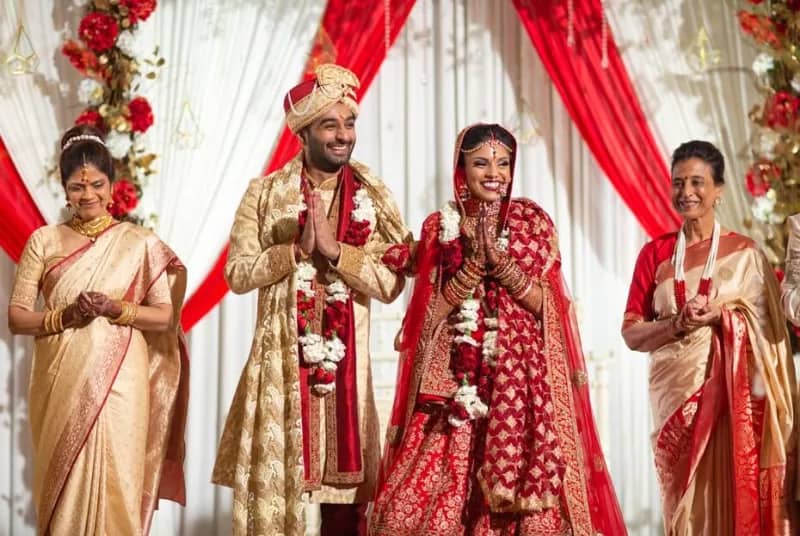ARRANGE MARRIAGE IN INDIA
A typical modern arranged marriage works as follows. For both men and women, the individual's parents or older family members screen for and find prospective mates for further consideration through their social circle, community, or by advertising on matrimonial websites or newspapers. There is an initial meeting in a family gathering, after which the couple has a few opportunities for chaperoned courtship. If neither party has vetoed the match and if they are so inclined, they may spend some time together alone.
And then it is time to make the decision. It is not unusual for the process from the initial introduction to the final yes/ no decision to unfold within a few days. A 2013 IPSOS survey found that 74% of young Indians (18-35 years old) prefer an arranged marriage over a free-choice one. Other sources report that as many as 90% of all Indian marriages are arranged.
There are two rather interesting and reliable statistics related to Indian arranged marriages. The first is that Indians have an astonishingly low divorce rate. Despite doubling in urban areas since 2007, only about 1 in 100 Indian marriages end in divorce. This is one of the lowest divorce rates in the world. Even more impressive is the second statistic, about the high levels of satisfaction reported by those in arranged marriages over the longer term.
A study in 2015 about relationship outcomes among Indian-American couples married either through free-choice or arranged marriages for about a decade found absolutely no differences. Those in arranged marriages were just as satisfied with their marriage and loved their partner as intensely as those who wed through free choice. Other studies have found similar results. Despite criticisms of self-selection and small sample sizes leveled against some of these studies, this is the best available evidence. It suggests that Indian arranged marriages are at least as successful as free-choice ones.
A typical modern arranged marriage works as follows. For both men and women, the individual's parents or older family members screen for and find prospective mates for further consideration through their social circle, community, or by advertising on matrimonial websites or newspapers. There is an initial meeting in a family gathering, after which the couple has a few opportunities for chaperoned courtship. If neither party has vetoed the match and if they are so inclined, they may spend some time together alone.
And then it is time to make the decision. It is not unusual for the process from the initial introduction to the final yes/ no decision to unfold within a few days. A 2013 IPSOS survey found that 74% of young Indians (18-35 years old) prefer an arranged marriage over a free-choice one. Other sources report that as many as 90% of all Indian marriages are arranged.
There are two rather interesting and reliable statistics related to Indian arranged marriages. The first is that Indians have an astonishingly low divorce rate. Despite doubling in urban areas since 2007, only about 1 in 100 Indian marriages end in divorce. This is one of the lowest divorce rates in the world. Even more impressive is the second statistic, about the high levels of satisfaction reported by those in arranged marriages over the longer term.
A study in 2015 about relationship outcomes among Indian-American couples married either through free-choice or arranged marriages for about a decade found absolutely no differences. Those in arranged marriages were just as satisfied with their marriage and loved their partner as intensely as those who wed through free choice. Other studies have found similar results. Despite criticisms of self-selection and small sample sizes leveled against some of these studies, this is the best available evidence. It suggests that Indian arranged marriages are at least as successful as free-choice ones.
ARRANGE MARRIAGE IN INDIA
A typical modern arranged marriage works as follows. For both men and women, the individual's parents or older family members screen for and find prospective mates for further consideration through their social circle, community, or by advertising on matrimonial websites or newspapers. There is an initial meeting in a family gathering, after which the couple has a few opportunities for chaperoned courtship. If neither party has vetoed the match and if they are so inclined, they may spend some time together alone.
And then it is time to make the decision. It is not unusual for the process from the initial introduction to the final yes/ no decision to unfold within a few days. A 2013 IPSOS survey found that 74% of young Indians (18-35 years old) prefer an arranged marriage over a free-choice one. Other sources report that as many as 90% of all Indian marriages are arranged.
There are two rather interesting and reliable statistics related to Indian arranged marriages. The first is that Indians have an astonishingly low divorce rate. Despite doubling in urban areas since 2007, only about 1 in 100 Indian marriages end in divorce. This is one of the lowest divorce rates in the world. Even more impressive is the second statistic, about the high levels of satisfaction reported by those in arranged marriages over the longer term.
A study in 2015 about relationship outcomes among Indian-American couples married either through free-choice or arranged marriages for about a decade found absolutely no differences. Those in arranged marriages were just as satisfied with their marriage and loved their partner as intensely as those who wed through free choice. Other studies have found similar results. Despite criticisms of self-selection and small sample sizes leveled against some of these studies, this is the best available evidence. It suggests that Indian arranged marriages are at least as successful as free-choice ones.




